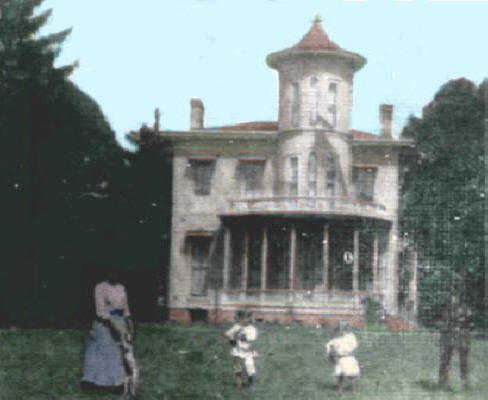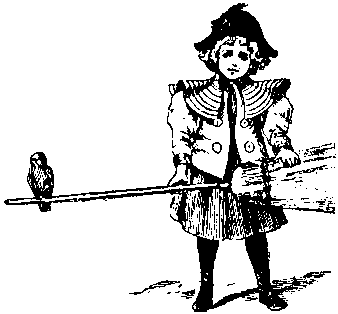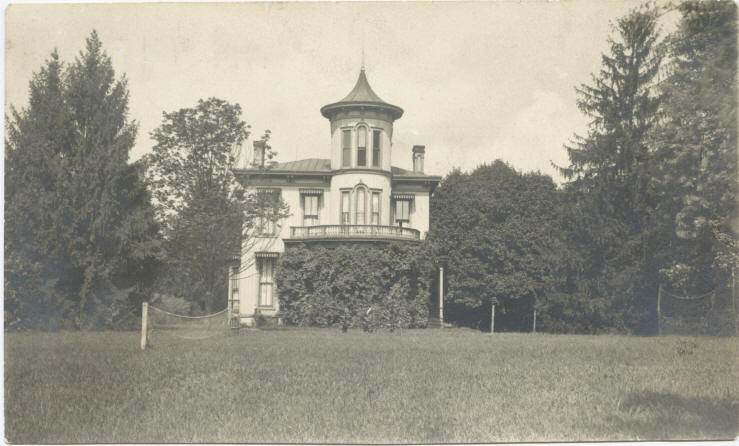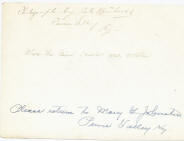Delacoosha: The Little Colonel Years
Home to the Burges, who Introduced Annie Fellows Johnston to Pewee (Lloydsboro) Valley and where the Little Colonel Stories began;
where she first met the irascible Old Colonel; where she first met Mom Beck and where “The Giant Scissors” was written.
Go to Delacoosha Part 2: The Mt. Mercy Camp & Boarding School Years

The Burge home, above, was built in about 1858 by James A. Miller, who also built another home in Pewee Valley known as Undulata.
Undulata was purchased by poet W.D. Gallagher, and seven years after his death, became the model for the Haunted House of Hartwell Hollow in the “Little Colonel” stories. Delacoosha was located next to the chapel built by St. Aloysius Church on Mt. Mercy Avenue in 1914.
It was demolished in 1982 and the Mt. Mercy Place subdivision was built on the site it formerly occupied. (Photo from “The Land of the Little Colonel,” published 1974 by Mrs. John S. Smith)
“On the 11th of October we were married at Trinity Church. It was the church my father had built the last year of his life. As soon as we were established in our new home, the children came to us from Kentucky where they had been in the home of an aunt for five years. They brought with them an ardent love for Kentucky. Pewee Valley to them was only another name for Paradise. They were all three bright, beautiful children with golden curls. John, the youngest, was only seven. Through them the Land of the Little Colonel was drawing closer to me, although I did not know it then.”
Annie Fellows Johnston,
In her autobiography,
Land of the Little Colonel (1929)
referring to her 1888 double wedding along with her younger sister Albion
When Annie Fellows married her mother’s cousin, William Levi Johnston, she took her first step toward writing the books that were destined to make both herself and the little town of Pewee Valley famous around the world.
Johnston, a widower, had three children by his previous marriage to Hallie Eaves: Rena, John and Mary. During his wife’s final illness, he sent his children to Pewee Valley, where they lived with his sister-in-law, Rena, her husband, Albert W. Burge, and his niece Hallie.
One of the people she might have heard about from her three step-children was Rebecca Porter and her husband Henry, who were the Burges’ live-in servants in 1880, according to the U.S. Federal Census. Rebecca Porter was destined to become Annie Fellows Johnston’s model for Mom Beck, the Little Colonel’s beloved nurse throughout the series.
In 1895, Annie Fellows Johnston made her first visit to Pewee Valley and stayed with the Burges. In Chapter VII of “Land of the Little Colonel” she wrote:
“EVER since the children had first come back from Kentucky they had talked so much of Pewee Valley that I felt acquainted with the place and the people. The girls went back every summer, and just after finishing “Joel” I went with John for a visit. It appealed to me as a most picturesque place, full of interesting characters.
I felt as if I had stepped back into a beautiful story of ante-bellum days. Back into the times when people had leisure to make hospitality their chief business in life, and could afford for every day to be a holiday; when there were always guests under the spreading rooftree of the great house, and laughter and singing in the servants’ quarters.”
It was during that visit that she encountered the irascible Colonel George Washington Weissinger; his similarly hot-tempered granddaughter, Hattie Cochran; and Rebecca Porter, destined to become the model for Mom Beck, the Little Colonel’s beloved nurse throughout the series. The story of how the first “Little Colonel” novel came into being was told nearly half a century later by the author’s niece, Hallie Burge (Jacob), in the following article by Hamilton Howard that appeared in the September 11, 1943 “Courier-Journal:”
The Naming of a Book
Mrs. Jacob, then of Pewee Valley, heard her mother suggest the story of “The Little Colonel”
Hattie Cochran, the original “Little Colonel” of literary fame, was, as anybody in Pewee Valley would tell you, a cute child but “bad as she could be.”
When the Little Colonel was three and Hallie Burge, now Mrs. Donald Jacob of Louisville, was just entering her teens, Mrs. Cochran brought Hattie over to visit Mrs. Burge and Annie Fellows Johnston. Mrs. Johnston, later to become author of the famous Little Colonel series of books, was staying at the old Burge Place visiting the Burges, cousins of Mr. Johnston.
People said little Hattie Cochran was just like her grandfather, Colonel Weissinger, who had a “vile tember and cursed every breath he took.” Hattie didn’t want to go home that afternoon. She dragged back, screamed, and sat down on the floor, beating it with her tiny heels.
Mrs. Burge turned to Mrs. Johnston, “Now, there,” she said, “Just write a book about that! And call it The Little Colonel!”
So Hallie Burge Jacob’s mother named The Little Colonel books! To talk to Mrs. Jacob is better than spending a week in Pewee Valley because the town has changed so much that reminiscence is the only way you can catch the flavor of the old days in Pewee.
“Mom” was Part Indian
Mom Beck, The Little Colonel’s nurse in the books, was actually Hallie Burge Jacob’s nurse. “She was very aristocratic,” Mrs. Jacob tells you. “Part Indian. She ruled the whole family– in fact, she was the only human being Poppa was afraid of!”
Mom Beck got her name because Hallie called both her old Negro mammy and Mrs. Burge “Momma.” Mrs. Burge stood it as long as she could, then decided the time had come for her to put her foot down. “You can’t keep calling us both “Momma,” she told her daughter. So the colored woman had to be called something else. Hallie dubbed her “Mom Beck.”
Hallie Burge must have been somewhat of a terror herself. Mom Beck kept a twig always handy to switch Hallie when she was bad. “But let Momma spank me,” she said, “and Mom Beck wouldn’t eat for three days!” She and the child would walk all over Pewee– Mom Beck carrying Hallie on her back — just as she carried “The Little Colonel” in Mrs. Johnston’s books.
“Polly in the Little Colonel books was my parrot, too,” she continued, “We had Polly ten years. When she died she was buried in Pewee Cemetery with a headstone and all. We never did know her age exactly so we put 58 years on the headstone!”
“She came from New Orleans and spoke only French at first. Later she learned English.”
An aunt who lived in Louisville gave the parrot to the Burges because the Polly used to get out on the front porch on Sundays and curse so raucously that people began to complain. So the parrot was shipped away to Pewee and has been immortalized along with Mom Beck in the Little Colonel books. Her picture, in fact, adorns one of the pages– perched on the end of a broomstick in the Little Colonel’s hand.

(Etheldred Barry’s Illustration from the book, 1895)
“We clipped one of Polly’s wings.” Mrs. Jacob continued. “But she went all over the house and grounds anyway. She would fly into the apple tree, sit there all day and sing to herself, ‘Oh Lawdy, I’m so happy — Oh, Lawdy, I’m so happy!’ “
Polly was never in her cage and her favorite diversion was to ride around from the stables to the house in the carriage. Eric, the Burge’s gardener, would hitch up the carriage when Mrs. Burge called him, “Eric, hitch up the carriage,” Polly learned to say it, too. She would screech, “Eric, hitch up the carriage!” Eric would drop what he was doing, hitch up and Polly would fly to the front seat.
Eric would drive around. “Here is the carriage, Mrs. Burge,” he would say.
“But I didn’t tell you, Eric,” she would answer.
“Yes, you did, Mrs. Burge,” he would say and Polly would cackle and laugh.
Colonel Weissinger must have been quite a frightening man but, you gather, Hallie Burge wasn’t the least afraid of him. “Poppa,” Mrs. Jacob said, “used to hunt birds. It wasn’t considered proper to serve birds fried in those days. Colonel Weissinger was over to dinner one Sunday after a hunting trip. We had two fowls on the table under covered dishes. Momma lifted the covers to serve and the Colonel exclaimed, “My God, Madam, you have fried birds on the table!”
“Momma stood up to him. ‘Colonel,’ she said, ‘you can just go home!’ He went and didn’t come back for three months!”
“Life was different in Pewee those days. Such a lovely town! Nobody worried. They would drive around to parties and entertainments all the time. We used to have house parties. Five or six men and girls came out on Saturday and stayed over Sunday. Buggy rides were a big event, but Momma didn’t allow me to go on buggy rides– just in carriages. I drove ten miles to a party in a horse break one time– you wouldn’t remember them. They were little narrow carriages with no back. My feet swung back and forth the whole way.”
“Momma never allowed us to sit under the trees. A boy could walk a girl around the circle in front of the house twice and then we had to come back and sit on the porch. We had to walk, too, Honey!”
“The boys would come to call and find ten or twelve other boys there on Sundays…then they would all leave and go calling on another girl. If a girl didn’t have ten or twelve men around, she wasn’t popular– she was disgraced! I was engaged to two or three boys at a time.”
When you hear Mrs. Jacob’s stories, when you realize she owned the original Polly, that Mom Beck was her nurse, and that she stood up to old Colonel Weissinger as a child, you wonder if you haven’t just been talking to the real original “Little Colonel.
Annie Fellows Johnston returned to Pewee Valley several times before she eventually purchased The Beeches in 1911 and made it her permanent home. The 1900 U.S. Census lists the following occupants of the Burge household:
- Albert W. Burge, Head, 44
- Hallie Burge, Daughter, 27
- Mamie (Mary G.) Johnston, Niece, 28
- John Johnston, 18, Nephew
- Annie (Fellows) Johnston, Niece (actually sister-in-law), 30
Albert Burge owned Delacoosha for over 20 years, until his death in 1915. Born in 1849, he came from a wealthy family. His father, Richardson Burge, was included in the “Biographical Encyclopedia of Kentucky of Dead and Living Men of the Nineteenth Century” published in 1877. According to the profile, he came to Louisville from Virginia in 1839 and became engaged in the tobacco trade. In addition to owning a large tobacco business, Richardson Burge was President of the People’s Insurance Company, organized by Louisville’s tobacco dealers in 1949, for many years; Vice President of the Falls City Tobacco Bank; and was also involved in the wholesale and retail carpet trades. He built his home on the site of Old Fort Nelson in 1855. Described as a “mansion,” the encyclopedia noted that the family was still living there at the time of its publication. The 1870 census lists its location as Louisville Ward 9 in Jefferson County and shows the following family members as residents:
- Richardson, 60, retired merchant, with real estate valued at $300,000 and his personal estate at $20,000
- Mary (Beatty) Burge, 43, Richardson’s third wife. The couple was married in 1868.
- Albert Burge, 21, unmarried and working in the leaf tobacco industry
- Mattie Burge, 18
- Emma Burge, 14, who would later marry Richard Mentor Johnston
- Mary Burge, 9
- Sallie Burge, 6, who would later marry Sidney Muir. Their child, Anna Burge Muir, became the model for Anna Moore in the “Little Colonel” stories
- Annie Burge, 5
- Elisha Applegate, Richardson Burge’s father-in-law from his second marriage to Louise Applegate in 1847 and natural grandfather to the six Burge children.
According to the encyclopedia, Albert W. Burge joined his father in the family business in 1870 with responsibility for exporting most of their tobacco to Europe. He married Rena Eaves shortly after going to work for his father. By the 1880 census, the couple was living in Delacoosha in Pewee Valley and had an eight-year-old daughter, Hallie Louise.
Rena Eaves Burge did not live long enough to see her daughter get married. She died in 1898, and Hallie tied the knot with architect Donald R. Jacob on July 1, 1903, according to Oldham County marriage records.
According to a letter written by Annie Fellows Johnston on Sepember 23, 1908:
…The first of September Hallie and her husband moved to San Antonio, where he had a fine offer to go into partnership with one of its leading architects. They have taken a house there and Mr. Burge, the dogs and servants will follow soon…
The 1910 census shows the Jacobs in San Antonio Ward 4, Bexar, Texas.
Albert Burge died on May 16, 1915 at his Pewee Valley home. Both he and his wife, Rena, are buried in Cave Hill Cemetery, Section B, Lot 21.
By the 1920 census, the Jacobs were living in Pewee Valley again, but on Central Avenue near Annie Fellows Johnston. By 1930, Donald was working as a vault manager at a bank and they had moved to Magisterial District 5 in Jefferson County, where they were sharing a rented house at 2448 Glenmary Avenue with William Culbertson Gatchel’s family. Billy Gatchel grew up in Pewee Valley at Woodside and was the son of Frank and Alice Craig Gatchel. Other Gatchel family members living at 2448 Glenmary included Billy’s first wife, Ninette Hite Gatchel; his mother-in-law, Ninette Hite; and his son, Frank E., who was a year old.
Donald Jacob died in 1954, Hallie ten years later on August 7, 1964 at Pewee Valley Hospital. Both are buried in Cave Hill Cemetery, Section G, Lot 65. Donald and Hallie are shown in the group picture on the Pewee Valley Post Office page.

The photo of the Burge House above was taken by Kate Matthews. The photo shown here is a scan of the original print, the one owned by Annie Fellows Johnston and used for her autobiography, Land of the Little Colonel (1929).
On the back of the photo above:
“Photograph by Kate Matthews, Pewee Valley, Ky-“
“Where the Giant Scissors was written”
Please return to Mary G Johnston, Pewee Valley Ky.”
Go to Delacoosha Part 2: The Mt. Mercy Camp & Boarding School Years
— Research and Narrative provided by Donna Russell, Pewee Valley Historical Society
